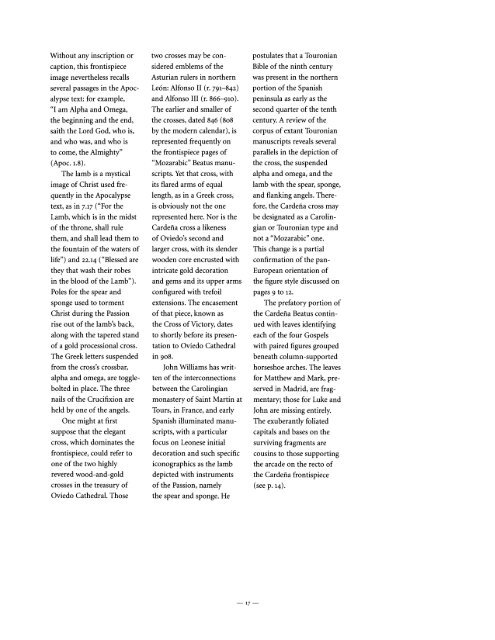The Metropolitan Museum of Art Bulletin, v. 59
The Metropolitan Museum of Art Bulletin, v. 59
The Metropolitan Museum of Art Bulletin, v. 59
- No tags were found...
You also want an ePaper? Increase the reach of your titles
YUMPU automatically turns print PDFs into web optimized ePapers that Google loves.
Without any inscription orcaption, this frontispieceimage nevertheless recallsseveral passages in the Apocalypsetext: for example,"I am Alpha and Omega,the beginning and the end,saith the Lord God, who is,and who was, and who isto come, the Almighty"(Apoc. 1.8).<strong>The</strong> lamb is a mysticalimage <strong>of</strong> Christ used frequentlyin the Apocalypsetext, as in 7.17 ("For theLamb, which is in the midst<strong>of</strong> the throne, shall rulethem, and shall lead them tothe fountain <strong>of</strong> the waters <strong>of</strong>life") and 22.14 ("Blessed arethey that wash their robesin the blood <strong>of</strong> the Lamb").Poles for the spear andsponge used to tormentChrist during the Passionrise out <strong>of</strong> the lamb's back,along with the tapered stand<strong>of</strong> a gold processional cross.<strong>The</strong> Greek letters suspendedfrom the cross's crossbar,alpha and omega, are toggleboltedin place. <strong>The</strong> threenails <strong>of</strong> the Crucifixion areheld by one <strong>of</strong> the angels.One might at firstsuppose that the elegantcross, which dominates thefrontispiece, could refer toone <strong>of</strong> the two highlyrevered wood-and-goldcrosses in the treasury <strong>of</strong>Oviedo Cathedral. Thosetwo crosses may be consideredemblems <strong>of</strong> theAsturian rulers in northernLeon: Alfonso II (r. 791-842)and Alfonso III (r. 866-91o).<strong>The</strong> earlier and smaller <strong>of</strong>the crosses, dated 846 (8o8by the modern calendar), isrepresented frequently onthe frontispiece pages <strong>of</strong>"Mozarabic" Beatus manuscripts.Yet that cross, withits flared arms <strong>of</strong> equallength, as in a Greek cross,is obviously not the onerepresented here. Nor is theCardefna cross a likeness<strong>of</strong> Oviedo's second andlarger cross, with its slenderwooden core encrusted withintricate gold decorationand gems and its upper armsconfigured with trefoilextensions. <strong>The</strong> encasement<strong>of</strong> that piece, known asthe Cross <strong>of</strong> Victory, datesto shortly before its presentationto Oviedo Cathedralin 908.John Williams has written<strong>of</strong> the interconnectionsbetween the Carolingianmonastery <strong>of</strong> Saint Martin atTours, in France, and earlySpanish illuminated manuscripts,with a particularfocus on Leonese initialdecoration and such specificiconographics as the lambdepicted with instruments<strong>of</strong> the Passion, namelythe spear and sponge. Hepostulates that a TouronianBible <strong>of</strong> the ninth centurywas present in the northernportion <strong>of</strong> the Spanishpeninsula as early as thesecond quarter <strong>of</strong> the tenthcentury. A review <strong>of</strong> thecorpus <strong>of</strong> extant Touronianmanuscripts reveals severalparallels in the depiction <strong>of</strong>the cross, the suspendedalpha and omega, and thelamb with the spear, sponge,and flanking angels. <strong>The</strong>re-fore, the Cardefna cross maybe designated as a Carolin-gian or Touronian type andnot a "Mozarabic" one.This change is a partialconfirmation <strong>of</strong> the pan-European orientation <strong>of</strong>the figure style discussed onpages 9 to 12.<strong>The</strong> prefatory portion <strong>of</strong>the Cardefna Beatus contin-ued with leaves identifyingeach <strong>of</strong> the four Gospelswith paired figures groupedbeneath column-supportedhorseshoe arches. <strong>The</strong> leavesfor Matthew and Mark, pre-served in Madrid, are fragmentary;those for Luke andJohn are missing entirely.<strong>The</strong> exuberantly foliatedcapitals and bases on thesurviving fragments arecousins to those supportingthe arcade on the recto <strong>of</strong>the Cardefia frontispiece(see p. 14).- 17 -
















